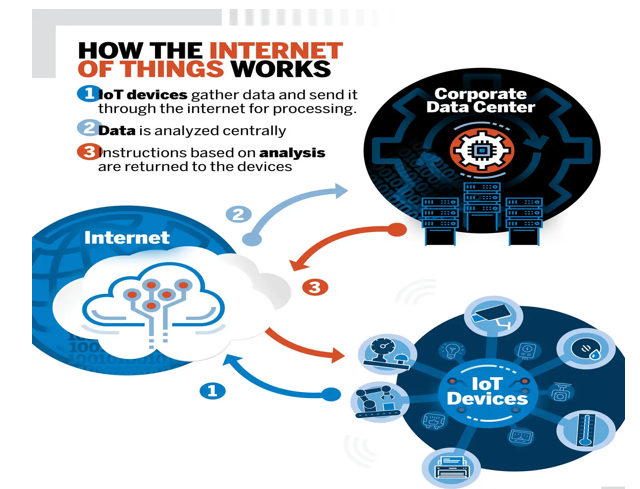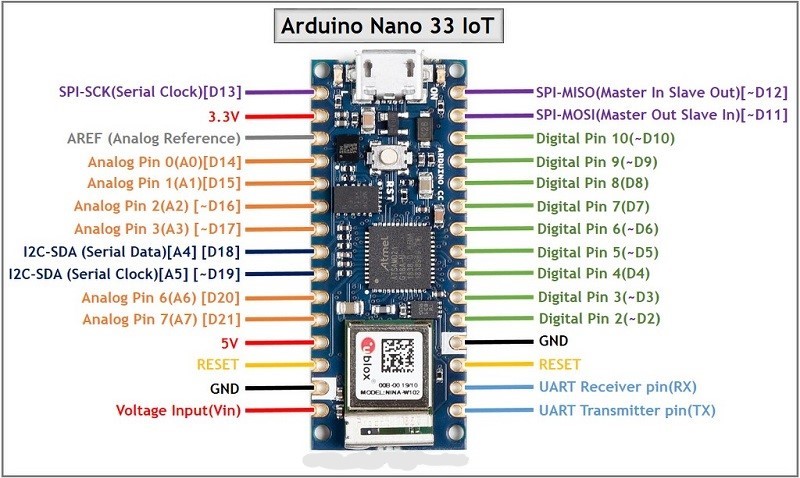
IOT (Internet Of Things)
In this article I have discussed about best Arduino board for IoT. The internet of things, a new terminology which is under frequent use now a day, is a wholesome new technological phase. It basically covers all the corners of a new networking era where sharing data, file and various other software would become very handy. It describes sensory physical objects, objects possessing processing ability, software, and other technological devices that interconnect and share data with other devices and systems over the internet or any other networking protocol. The key feature of IOT is that the devices need not to be connected to the public internet rather they only are connected to a shared and combined network and are individually accessible via an address. Thus the devices are provided with Unique Identifiers (UID). They possess the ability of transferring data over a network without the interaction between two users or a user and a computer.
A thing in IOT can be any electronic digital device that works on the digital principles and is programmable. For example, this thing can be an interceptor radar used for detecting incoming missiles within its range, or a human heart pacer that is made functional inside a human being after some damage to his heart or it can also be just a signal check light indicating low tire pressure in any wheel of a digitally assembled car. IOT is being used extensively by a number of organizations for their more efficient and better service providing to users, making their industries and organizations worth a fortune.

Peter T. Lewis invented both the concept and name of “Internet of Things” in a speech to Congressional Black Caucus Foundation 15th Annual Legislative Weekend in Washington, DC, in 1985. According to Lewis, “The Internet of Things, or IOT, is the integration of people, processes and technology with connectable devices and sensors to enable remote monitoring status, manipulation and evaluation of trends of such devices.”
Working of IoT
An IOT system works on the principle of embedded systems. They usually consist of web-enabled smart devices that use the principles of embedded systems for their multitasking. These devices can be processors, sensory devices and communication tools that are used to collect and send data and sometimes interpret it. These devices then set-up their own networking gateway with the help of which these devices communicate. This gateway serves the purpose of analyzing data sent to cloud or local. Sometimes these devices intercommunicate to alter the information to be handled, process it and then upload the final formulated result to the gateway.

The whole networking and connectivity protocols used in IOT are very specified. These specified protocols largely depend on the web=enabled devices and their application. IOT has already speeded its progress and has been successful to interact with the latest and till now the most advanced shape of technology i.e. Artificial Intelligence (AI) and Machine Learning (ML). These new emerging fields of science are also adopting the method that IOT has been practicing to establish a communication between devices and their network protocols. Self-driven vehicles are a good example of communication established between the device and its components where the driver needs to relax and the car using its embedded system will judge the environment around it and will provide the diver a safe drive from one destination to another.
Importance of IoT
Like science, the importance of IOT in our daily life cannot be ignored. It has been successful to provide benefits to various organizations and departments. Some benefits can be related to human while other prove quite useful and resourceful for various large industries and organizations. Some most common benefits IOT enabled businesses are
- Securing the business by providing constant monitoring to business data
- Customer friendly
- Time and money efficient
- Provide better productive chances to employees
- Integrate business models and adapt changes necessary to promote the business
- Resourceful and more revenue generation
As the world is progressing towards digital transformation it becomes necessary for every phase of life to adapt advancement and avail better future opportunities. Not just business but by converting the whole world into a global village, every individual would be able seek equal opportunities and every individual will then serve as a carrier of information.
Pros & Cons of IoT
But every great invention or idea has some pros and cons so does IOT.
The advantages of implementing IOT system are
- Information would be accessible at anytime and anywhere
- Inter-devices communication would be a drastic change
- Time efficiency and money saving would be assured while transferring data
- Task automation: effortless work
But the risks that IOT offers are also a matter of great concern
- As a large number of devices would be connected in a cloud, it would be easy for a hacker to hack that cloud and access the information within
- BUGS, if any in any system, they would spread to all the systems connected
- Since the international compatibility for IOT is none, the chance of refusal increases if the masses cannot communicate with each other
IoT & Arduino
To ensure stable connection between different devices connected to a network portal, IOT and Arduino collectively introduce Arduino IOT cloud. It is a platform where anyone can create IOT projects with user defined interface and using Arduino can configure, code, upload and visualize.

Arduino IoT Features
Arduino IOT cloud offers following key feature which attracts the user and he is forced to use the cloud. The charming features offer a lot with a very suitable scale. Following are the feature offered
- DATA MONITORING: Arduino’s sensory devices and values allows the user to constantly monitor data ever after very short interval of time regardless of the repetitions/iterations
- VARIABLE SYNCHRONIZATION: a methodology allowing user to sync variables introduced across the device. This promotes communication quality between devices and minimal coding
- SCHEDULER: as the name suggests, it keeps the track of time and thus acts as a switch to either be in ON or OFF state for a specific amount of time thus maintaining a schedule to follow
- OVER–THE-AIR (OTA) UPLOADS: as name specifies, it works wirelessly, uploading code to devices that are not physically in contact
- WEBHOOK: used for integration of project
- AMAZON ALEXA SUPPORT
- DASHBOARD SHARING
Best Arduino for IoT
NANO 33 IoT
NANO 33 involves nanotech but also interacts with the basic IOT and pico-network applications. It serves as a multipurpose Arduino. Whether we have to connect it in the office or home, whether it is connected with sensory devices or itself is acting as a sensory device using Bluetooth, this device has many uses. Plus, a low energy device is always welcome in today’s world which serve as a solution to many daily life problems.

The Arduino Nano 33 IOT is Arduino’s smallest board which got inducted in internet applications by IOT. It uses Arm® Cortex®-M0 32-bit SAMD21 processor, which makes it fit for race. It also features u-blox NINA-W102 Wi-Fi module as well as the ECC608A crypto-chip for security.
Other Examples of Arduino for IoT
Some other Arduino boards can also be used for IOT cloud. They share almost the same function as NANO 33 IOT. They are as follow
- MKR 1000 WI-FI
- MKR Wi-Fi 1010
- MKR WAN 1300
- MKR GSM 1400
- MKR NB 1500
- NANO RP2040 CONNECT
- PORTENTA H7
- NICLA VISION
Best Arduino Boards for Robotics, IoT and WiFi
Arduino Vs Raspberry Pi: Comparison Between Arduino and Raspberry Pi
Remote Access Technologies for Monitoring Environmental Variables Based on Arduino
How to Design an Arduino based Color Mixer?
Network Security Enabled Arduino Devices for Military Communication
Design an Portable Ultrasonic Range Meter using Arduino
Design of smart electronic voting machine using Arduino
How to control the speed and direction of DC motor using Arduino?
How to Display on 8×8 Dot Matrix LED Using Arduino(UNO)?
How to Design RGB Mood Lamp using Arduino?
Serial Temperature Sensor Project using Arduino
How to design an LED Flasher on Arduino Board
Design of Traffic Light Control system using Arduino
Arduino Project: How to control the speed of DC motor?
Arduino Project: Send Command with Serial Communication
Arduino Project: LED Fire Effect